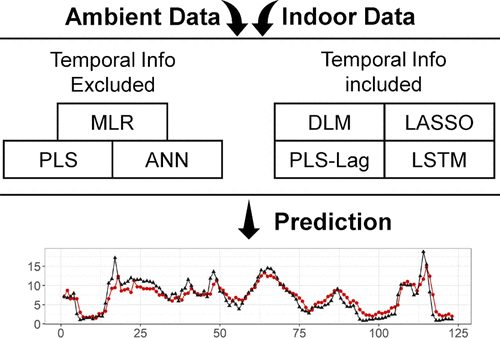当前位置:
X-MOL 学术
›
Environ. Sci. Technol.
›
论文详情
Our official English website, www.x-mol.net, welcomes your
feedback! (Note: you will need to create a separate account there.)
Predicting PM2.5 in Well-Mixed Indoor Air for a Large Office Building Using Regression and Artificial Neural Network Models
Environmental Science & Technology ( IF 10.8 ) Pub Date : 2020-11-17 , DOI: 10.1021/acs.est.0c02549 Brent Lagesse 1 , Shuoqi Wang 2 , Timothy V. Larson 2 , Amy A. Kim 2
Environmental Science & Technology ( IF 10.8 ) Pub Date : 2020-11-17 , DOI: 10.1021/acs.est.0c02549 Brent Lagesse 1 , Shuoqi Wang 2 , Timothy V. Larson 2 , Amy A. Kim 2
Affiliation

|
Although the exposure to PM2.5 has serious health implications, indoor PM2.5 monitoring is not a widely applied practice. Regulations on the indoor PM2.5 level and measurement schemes are not well established. Compared to other indoor settings, PM2.5 prediction models for large office buildings are particularly lacking. In response to these challenges, statistical models were developed in this paper to predict the PM2.5 concentration in well-mixed indoor air in a commercial office building. The performances of different modeling methods, including multiple linear regression (MLR), partial least squares regression (PLS), distributed lag model (DLM), least absolute shrinkage selector operator (LASSO), simple artificial neural networks (ANN), and long-short term memory (LSTM), were compared. Various combinations of environmental and meteorological parameters were used as predictors. The root-mean-square error (RMSE) of the predicted hourly PM2.5 was 1.73 μg/m3 for the LSTM model and in the range of 2.20–4.71 μg/m3 for the other models when regulatory ambient PM2.5 data were used as predictors. The LSTM models outperformed other modeling approaches across the performance metrics used by learning the predictors’ temporal patterns. Even without any ambient PM2.5 information, the developed models still demonstrated relatively high skill in predicting the PM2.5 levels in well-mixed indoor air.
中文翻译:

使用回归和人工神经网络模型预测大型办公大楼室内混合空气中的PM 2.5
尽管暴露于PM 2.5会对健康产生严重影响,但室内PM 2.5监控尚未广泛应用。关于室内PM 2.5水平和测量方案的法规尚不完善。与其他室内环境相比,尤其缺少大型办公楼的PM 2.5预测模型。为了应对这些挑战,本文开发了统计模型来预测PM 2.5集中在一幢商业办公大楼内混合良好的室内空气中。不同建模方法的性能,包括多元线性回归(MLR),偏最小二乘回归(PLS),分布式滞后模型(DLM),最小绝对收缩选择器算子(LASSO),简单人工神经网络(ANN)和比较短期记忆(LSTM)。环境和气象参数的各种组合被用作预测因子。预测每小时PM的根均方误差(RMSE)2.5为1.73微克/米3的LSTM模型和在2.20-4.71微克/ m的范围内3为其他模型时调控环境PM 2.5数据用作预测指标。通过学习预测变量的时间模式,LSTM模型在使用的性能指标上胜过其他建模方法。即使没有任何环境PM 2.5信息,开发的模型在预测混合室内空气中PM 2.5的水平方面仍显示出较高的技巧。
更新日期:2020-12-01
中文翻译:

使用回归和人工神经网络模型预测大型办公大楼室内混合空气中的PM 2.5
尽管暴露于PM 2.5会对健康产生严重影响,但室内PM 2.5监控尚未广泛应用。关于室内PM 2.5水平和测量方案的法规尚不完善。与其他室内环境相比,尤其缺少大型办公楼的PM 2.5预测模型。为了应对这些挑战,本文开发了统计模型来预测PM 2.5集中在一幢商业办公大楼内混合良好的室内空气中。不同建模方法的性能,包括多元线性回归(MLR),偏最小二乘回归(PLS),分布式滞后模型(DLM),最小绝对收缩选择器算子(LASSO),简单人工神经网络(ANN)和比较短期记忆(LSTM)。环境和气象参数的各种组合被用作预测因子。预测每小时PM的根均方误差(RMSE)2.5为1.73微克/米3的LSTM模型和在2.20-4.71微克/ m的范围内3为其他模型时调控环境PM 2.5数据用作预测指标。通过学习预测变量的时间模式,LSTM模型在使用的性能指标上胜过其他建模方法。即使没有任何环境PM 2.5信息,开发的模型在预测混合室内空气中PM 2.5的水平方面仍显示出较高的技巧。











































 京公网安备 11010802027423号
京公网安备 11010802027423号